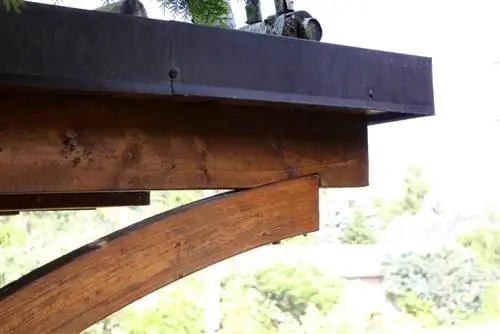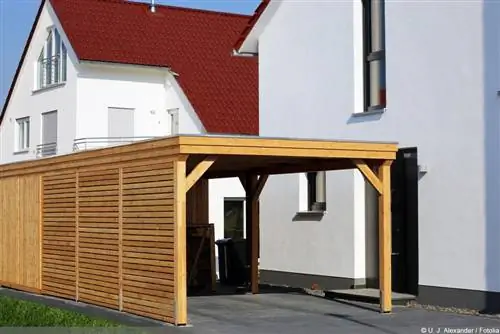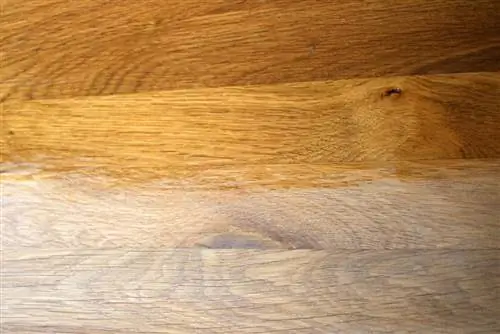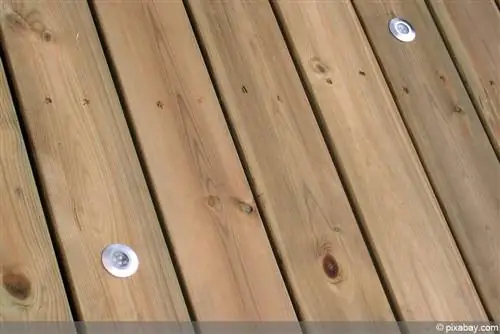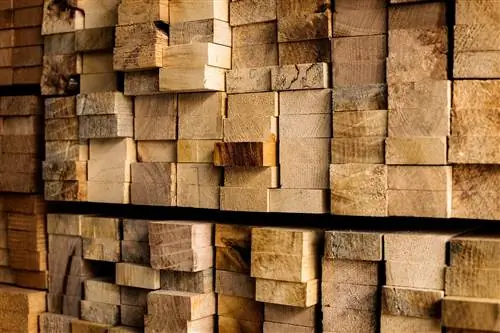- Author admin [email protected].
- Public 2023-12-17 03:39.
- Last modified 2025-01-24 12:45.
A wooden carport doesn't just offer a place to park your car. Structurally well planned, it fits harmoniously into the house and garden. While a massive garage often appears bulky and takes up a lot of space on the property, a carport offers visual freedom and keeps the property spacious.
A carport is the ideal parking space
It's actually not the garage, but the carport that is often the better place to park the car. Here the car is parked in a well-ventilated place. Vehicles often rust in a garage because there is no ventilation. There are now many models of prefabricated carports available in hardware stores. However, they are often very simple and have no visual impact. They are practical, but often not an ornament for the home and garden. So if you have craftsmanship, you are well advised to build your own carport. Once you have decided to build a carport, the question arises as to what material it should be made of.
The most natural and easy-to-process building material is wood. It visually fits into every house and every garden and is relatively easy to process. Not only are there different types of wood to choose from, it must also be decided in advance whether the carport should be made of solid wood or glued wood.
Carport made of glued wood, solid structural wood or timber
What is the difference between glued wood, solid structural wood and glued wood? The biggest differences lie in the moisture content of the wood and its stability.
Glued wood
Glued timber (glued laminated timber) is made from ordered, thin layers of boards glued together in a weatherproof manner and has a very low level of wood moisture. This means it works less, is free of cracks and its surface is set and planed to a high quality. Thanks to the good drying, glued wood is resistant to fungal attack and wood pests. The glued wood is characterized by optimal dimensional stability, high dimensional stability, very long optical quality and durability.
Solid construction wood
Solid construction timber is also known as lumber. It is a solid wood made from pine, fir, larch or spruce, cut with calibrated measuring devices and artificially dried, which has a maximum moisture content of 15 percent. Artificial drying also achieves high dimensional stability. Visually, the drying process improves the quality of the cut construction wood.
Lumber
Pressure-impregnated timber has a higher wood moisture content. It has been treated against pest infestation and rot. Pressure vessels cause pressure impregnation with excess pressure and heat and make the wood durable. The moisture absorbed is a disadvantage. The wood works when it dries in the air. It may warp and some cracks may appear.
The wood for every requirement
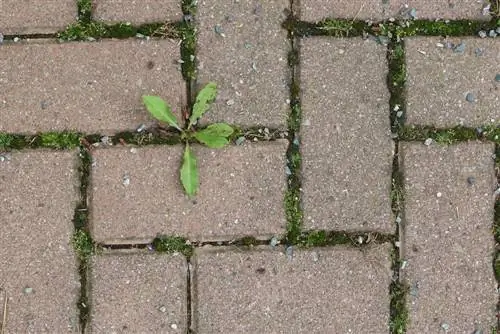
The most common option is to build a carport out of pine construction wood. It is easy to process and visually effective thanks to the clearly visible resin channels and annual ring structures. If you accept that a beam can warp or crack, building a carport out of pressure-impregnated lumber is the most cost-effective option. If you want your carport to be long-lasting and flawless, you should use glued wood. When it comes to weather resistance, glued wood is not inferior to solid softwoods. It doesn't tear, there are hardly any warps and it is more resilient to tension and pressure. It is the more expensive, but also more dimensionally stable variant. The following applies to all woods:
- They have no UV protection and should be painted so that the wood does not turn gray. An open-pored wood protection glaze is recommended.
- Wooden stands should never stand directly on the floor. Despite being painted, the wood absorbs too much moisture in rainy seasons and the construction is damaged.
- Each post should be placed on a post base. The post bases are set in concrete to ensure stability.
Tips to consider
- Never put wood directly into the ground. Any wood rots when it comes into direct contact with the ground.
- The roof of a carport should have a slope of 10 degrees so that rainwater can drain away.
- Before building a carport, ask the responsible building authority whether a building permit is necessary and how far the distance to the neighboring property must be.
- The posts give the carport the necessary stability. For static and optical reasons they should be at least 9 x 9 cm thick.
- The shape of the roof can make the difference. It should fit the house and its surroundings.
- When selecting the roof covering, the possible snow load should not be underestimated. This applies to plastic, metal and also wood.
- Measure the carport height and width generously. The inner distances of the posts are decisive.
- Even softwood that has already been impregnated needs to be visually refreshed after a few years. Only larch and Douglas fir can do without a refresh. Over time, they acquire a grey-silvery and elegantly shimmering surface and only need to be refreshed with glaze if you want to retain the reddish shimmer of the wood.
- The low-torsion glued wood shows little or no cracking. An open-pored wood protection glaze is the ideal basis for long-lasting enjoyment.
Tips for speed readers
- Carport kits are not always the better choice
- Lumber has a higher wood moisture content and can warp slightly
- Construction wood has a maximum residual moisture of 15 percent, little warping
- Glued wood is dry and almost free of distortion
- Always protect wood against UV light with wood protection glazes
- Always mount wooden stands on post supports so that they do not rot
- Observe a roof gradient of at least 10 degrees
- Ask for building permits from the relevant municipality
- Inquire and observe the distance to the neighboring property
- Refresh softwood in due course
- Prefer open-pored wood protection glaze
- Adapt roof covering visually to the house or location
- Consider snow load when roofing
What you should know about carport material in brief
Glued wood
- Glued wood is made from individual, thin, artificially arranged layers of boards glued together in a weatherproof manner.
- It complies with building regulations requirements and is subject to regular quality monitoring for load-bearing wooden parts.
- Due to the manufacturing process, glued wood has an extremely low wood moisture content.
- This means that the wood works much less and has a high degree of dimensional stability and dimensional stability.
- It is largely free of cracks and has a high-quality surface (planed and set).
- Due to the artificial drying, it is insensitive to wood pests and fungal attack, as they only love damp wood.
- This results in a long service life and optical high quality.
Pressure-treated lumber
- Pressure impregnated lumber is treated against rot and pest infestation.
- Pressure impregnation is used to introduce all kinds of protective agents deep into the wood.
- This is done in pressure vessels with heat and excess pressure. Posts are made durable through high-pressure injection.
- The disadvantage is that the wood absorbs moisture and dries again and again. This causes the wood to work and can warp and cracks.
Solid construction wood
- Solid construction timber is also known as lumber.
- Solid structural wood is visually or mechanically sorted, technically dried and calibrated solid wood made from spruce, fir, pine or larch.
- The term “solid structural timber” is not standardized, but an invention of the timber industry.
- The sawmill industry guarantees that the solid structural timber has a maximum moisture content of 15% when delivered to the construction site.
- This moisture content is achieved through artificial drying.
- At the same time, greater dimensional accuracy is achieved and the optical quality of the cut lumber is improved.
Conclusion
All wood does not offer protection from UV radiation and should be painted. A color-pigmented protective glaze is recommended for all woods to protect against UV radiation (wood graying). The fact is that using pressure-impregnated wood is the cheapest option; the other two wood options are more expensive depending on their quality. However, if you want your carport to have a certain longevity, you should use glued laminated wood or solid structural wood.

